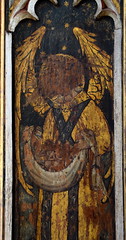 |
|
I kept
meaning to come back to Southwold
- the church, I mean, for I found
myself in the little town from
time to time. I finally kept my
promise to myself in the summer
of 2017, tipping up on a
beautiful sunny day only to find
the church closed for extensive
repairs. The days got shorter,
and by the time the church
reopened it was too late in the
year for me to try again. In
fact, it was not until late
October 2018 that I made it back
there, on another beautiful day.
Southwold is well-known to people
who have never even been there I
suppose, signifying one side of
Suffolk to which Ipswich is
perhaps the counter in the
popular imagination. Some thirty
years ago, the comedian Michael
Palin made a film for television
called East of Ipswich.
It was a memoir of his childhood
in the 1950s, and the basic comic
premise behind the film was that
in those days families would go
on holiday to seaside resorts on
the East Anglian coast. In the
child Palin's case, it was
Southwold.
The amusement came from the idea
that people in those days would
sit in deckchairs beside the grey
north sea, or shelter from the
drizzle in genteel teashops or
the amusement arcade on the pier.
In the Costa Brava package tour
days of the 1980s, the quaintness
of this image made it seem like
something from a different world. |
I remember Southwold in the
1980s. It was one of those agreeable
little towns distant enough from anywhere
bigger to maintain a life of its own. It
still had its genteel tea shops, its
dusty grocers, its quaint hotels and pubs
all owned by Adnams, the old-fashioned
and unfashionable local brewery. In the
white heat of the Thatcherite cultural
revolution, it seemed a place that would
soon die on its feet quietly and
peaceably.
And then, in the 1990s, the colour
supplements discovered the East Anglian
coast, and fell in love with it. The new
fashions for antique-collecting, cooking
with local produce and general country
living, coupled with a snobbishness about
how vulgar foreign package trips had
become, conspired to make places like
Southwold very sought after. Before Nigel
Lawson's boom became a bust, the inflated
house prices of London and the home
counties gave people money to burn. And
in their hoards, they came out of the big
city to buy holiday homes in East Anglia.
Although they are often lumped together,
the coasts of Norfolk and Suffolk are
very different to each other
(Cambridgeshire and North Essex are also
culturally part of East Anglia, but the
North Essex coast is too close to London
to have ever stopped being cheap and
cheerful, and Cambridgeshire has no
coastline). Norfolk's beaches are wide
and sandy, with dunes and cliffs and rock
pools to explore. Towns like Cromer and
Hunstanton seem to have stepped out of
the pages of the Ladybird Book of the
Seaside. Tiny villages along the
Norfolk coast have secret little beaches
of their own.
Suffolk's coast is wilder. Beaches are
mainly pebbles rather than sand, and the
marshes stretch inland, cutting the coast
off from the rest of the county. Unlike
Norfolk, Suffolk has no coast road, and
so the settlements on the coast are
isolated from each other, stuck at the
ends of narrow lanes which snake away
from the A12 and peter out in the
heathland above the sea. There are fewer
of them too. It is still quicker to get
from Walberswick to Southwold by water
than by land. Because they are isolated
from each other, they take on individual
personalities and characteristics.
Because they are isolated from the land,
they become bastions of polite
civilisation.
Between Felixstowe in the south, which no
outsiders like (and consequently is the
favourite of many Suffolk people) and
Lowestoft in the north, which is
basically an industrial town-on-sea (but
which still has the county's best beaches
- shhh, don't tell a soul) are half a
dozen small towns that vie with each
other for trendiness. Southwold is the
biggest, and today it is also the most
expensive place to live in all East
Anglia. Genteel tea shops survive, but
are increasingly shouldered by shops that
specialise in ski-wear and Barbour
jackets, delicatessens that stock
radicchio and seventeen different kinds
of olive, jewellery shops and kitchen
gadget shops and antique furniture shops
where prices are exquisitely painful.
Worst of all, the homely, shabby,
smoke-filled Sole Bay Inn under the
lighthouse has been converted by the
now-trendy Adnams Brewery into a chrome
and glass filled wine bar.
If you see someone in Norfolk driving a
truck, they are probably wearing a
baseball cap and carrying a shotgun. in
Suffolk, they've more likely just bought
a Victorian pine dresser from an antique
shop, and they're taking it back to
Islington. Does this matter? The fishing
industry was dying anyway. The tourist
industry was also dying. If places like
Southwold, Aldeburgh and Orford become
outposts of north London, at least they
will still provide jobs for local people.
But the local people won't be able to
afford to live there, of course. They'll
be bussed in from Reydon, Leiston and
Melton to provide services for people in
holiday cottages which are the former
homes they grew up in, but can no longer
afford to buy. Does this seriously annoy
me? Not as much as it does them, I'll
bet.
So, lets go to Southwold, turning off the
A12 at the great ship of Blythburgh
church, the wide marshes of the River
Blyth spreading aimlessly beyond the
road. We climb and fall over ancient
dunes, and then the road opens out into
the flat marshes, the town spreads out
beyond. We enter through Reydon (now
actually bigger than Southwold, with
houses at half the price) and over the
bridge into the town of Southwold itself.
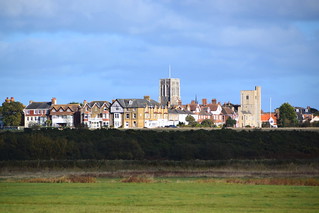
Having been so
critical, I need to say here that
Southwold is beautiful. It is quite the
loveliest small town in all East Anglia.
None of the half-timbered houses here
that you find in places like Long Melford
and Lavenham. Here, the town was
completely destroyed by fire in the 17th
century, and so we have fine 18th and
19th century municipal buildings. One of
the legacies of the fire was the creation
of wide open spaces just off of the high
street, called greens. The best one of
all is Gun Hill Green, overlooking the
bay where the last major naval battle in
British waters was fought. The cannons
still point out to sea. The houses here
are stunning, gobsmacking, jaw-droppingly
wonderful. If I could afford to buy one
of them as a weekend retreat, then you
bet your life I would, and to hell with
the people who moaned about it.
At the western end of the High Street is
St Bartholomew's Green, and beyond it
sits what is, for my money, Suffolk's
single most impressive building. This is
the great church of St Edmund, a vast
edifice built all in one go in the second
half of the 15th century. Only Lavenham
can compete with it for scale and
presence. Unlike the massing at St Peter
and St Paul at Lavenham, St Edmund is
defined by a long unbroken clerestory and
aisles beneath - where St Peter and St
Paul looks full of tension, ready to
spring, St Edmund is languid and
floating, a ship at ease.
Southwold church was just one of several
vast late medieval rebuildings in this
area. Across the river at Walberswick and
a few miles upriver at Blythburgh the
same thing happened. Blythburgh still
survives, but Walberswick was derelicted
to make a smaller church, as were
Covehithe and Kessingland. Dunwich All
Saints was lost to the sea. But Southwold
was the biggest. Everything about it
breathes massive permanence, from the
solidity of the tower to the turreted
porch, from the wide windows to the
jaunty sanctus bell fleche.
Along the top of the aisles, grimacing
faces look down. All of them are
different. The pedestals atop the
clerestory were intended for statues as
at Blythburgh, but were probably never
filled before the Reformation intervened.
At the west end, above the great west
window, you can see the vast inscription SAncT
EDMUND ORA P: NOBIS ('Saint Edmund,
pray for us') as bold a record of the
mindset of late medieval East Anglian
Catholicism as you'll find.
 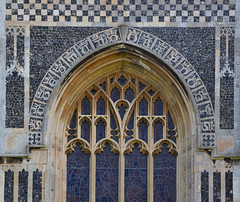 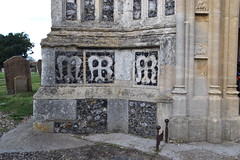
 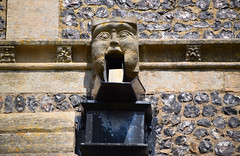 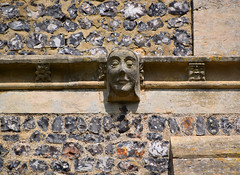
As at Lavenham and
Long Melford, the interior has been
extensively restored, but not in as heavy
or blunt a manner as at those two
churches. St Edmund has, it must be said,
benefited from the attentions of German
bombers who put out all the dull
Victorian glass with blast damage during
World War II. Here, the interior is vast,
light and airy, and much of the
restoration is 20th century work, not
19th century.
Perhaps because of this, more medieval
interior features have survived. Unlike
Long Melford, Southwold does not have
surviving medieval glass (Mr Dowsing saw
to that in 1644), but it does have what
is the finest screen in the county.
It stretches right the way across the
church, and is effectively three separate
screens. There is a rood screen across
the chancel arch, and parclose screens
across the north and south chancel
aisles. All retain their original dado
figures. There are 36 of them, more than
anywhere else in Suffolk. They have been
restored, particularly in the central
range, but are fascinating because they
retain a lot of original gesso work,
where plaster of Paris is applied to wood
and allowed to dry. It is then carved to
produce intricate details.
The central screen shows the eleven
remaining disciples and St Paul. They
are, from left to right, Philip,
Bartholomew, James the Less, Thomas,
Andrew, Peter, Paul, John, James, Simon,
Jude and Matthew.

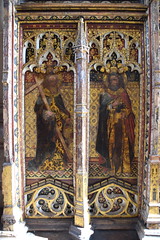  
 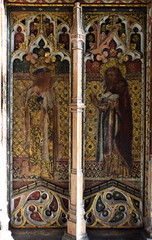 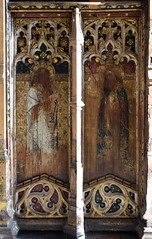
The south chancel chapel is
light and open. The bosses above are said
to represent Mary Tudor and her second
husband Charles, Duke of Brandon. The
screen here is painted with twelve Old
Testament prophets, and Mortlock suggests
that they are by a different hand to the
images on the other two screens. Here on
the south screen, some of the figures
have surviving naming inscriptions, and
Mortlock surmises that the complete
sequence, from left to right, is Baruch,
Hosea, Nahum, Jeremiah, Elias, Moses,
David, Isaiah, Amos, Jonah and Ezekiel.
Further, he observes that the subject is
a usual one for the English Midlands, but
rare for East Anglia, and that perhaps
this part of the screen came from
elsewhere. The same may be true of the
other two parts - it is hard to think
that the central screen was deliberately
made too wide for the two arcades.
  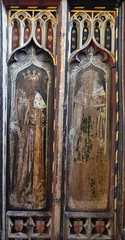 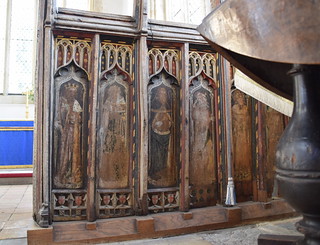
The north aisle chapel is
reserved as the blessed sacrament chapel,
and its screen is probably the most
interesting of the three. This screen is
harder to explore, because the northern
side is curtailed by a large chest, but
it features angels. Unlike the screens at
Hitcham and Blundeston, which show angels
holding instruments of the passion, these
are the nine orders of angels, with
Gabriel at their head, and flanked by
angels holding symbols of the Trinity and
the Eucharist. Mortlock says that they
are so similar to the ones at Barton Turf
in Norfolk that they may be by the same
hand, in which case the central screen is
also by that person. They are, from left
to right, the Holy Trinity, Gabriel,
Archangels, Powers, Dominions, Cherubim,
Seraphim, Thrones, Principalities,
Virtues, Messengers, and finally the
Eucharist. The Holy Trinity angel still
has part of the original dedicatory
inscription beneath his feet.
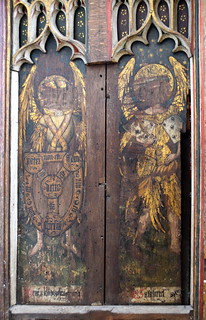 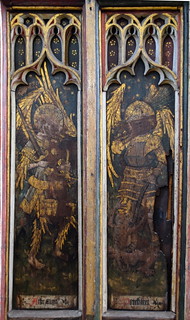 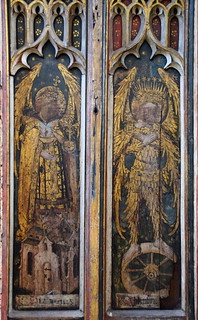
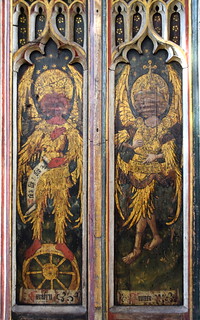  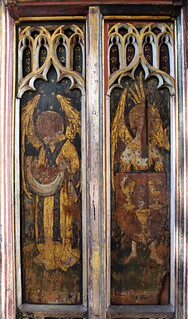
If part or all of this
screen came from elsewhere, where did it
come from? Possibly either Walberswick,
Covehithe or Kessingland, the three
downsized churches mentioned earlier.
More excitingly, it might have come from
one of the churches along this coast that
was lost to the sea, perhaps neighbouring
St Nicholas at Easton Bavents, or, just
to the south, St Peter or St John the
Baptist, the two Dunwich churches lost in
the 16th and 17th centuries. We'll never
know.
If you turn back at the screen and face
westwards, your eyes are automatically
drawn to the towering font cover, part of
the extensive 1930s redecoration of the
building. The clerestory is almost like a
glass atrium intended to house it. Also
the work of the period is the repainting
and regilding of the 15th century pulpit
(a lot of people blanch at this, but I
think it is gorgeous) and the lectern.
Beneath the font cover, the font is
clearly one of the rare seven sacraments
series, and part of the same group as
Westhall, Blythburgh and Wenhaston. As at
Blythburgh and Wenhaston, the panels are
completely erased, probably in the 19th
century, an act of barbarous vandalism.
Given that Westhall is probably the best
of all in the county, we must assume that
three major medieval art treasures were
wiped out. Astonishingly, vague shadows
survive of the former reliefs; you can
easily make out the Mass panel, facing
east as at Westhall, the Penance panel
and even what may be the Baptism of
Christ.
Stepping through the screen, the reredos
ahead is by Benedict Williamson and the
glass above by Ninian Comper, familiar
names in the Anglo-catholic pantheon, and
evidence of an enthusiasm here that still
survives in High Church form. The Comper
east window depicts St Edmund in his four
guises as youth, king, martyr and saint,
an interesting idea, but it is perhaps
not the best executed window in the
Comper canon. There is a good engraved
glass image of St Edmund to the north of
the sanctuary by John Hutton, placed here
in 1971, very much of its period. As
James Bettley notes in the revised
Pevsner, it is better seen from the
outside. On the wall of the chancel to
the west of it, the high organ case is
also painted and gilded enthusiastically.
As well as the screen, Southwold's other
great medieval survival is the set of
return stalls either side of the eastern
face of the chancel screen. The bench
ends feature the kneeling donors in
profile, and there are misericord seats,
but the best features are the handrests
between the seats. On the south side,
carvings include a man with a horn-shaped
hat and sinners being drawn into the
mouth of hell. On the north side are a
man playing two pipes, a monkey preaching
and a beaver biting its own genitals, a
tale from the medieval bestiary,
apparently.
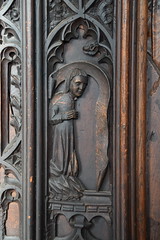 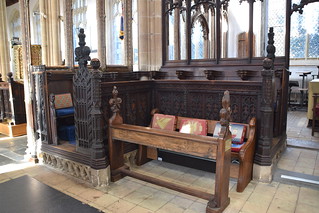 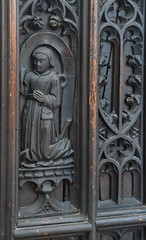
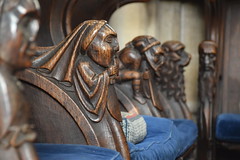 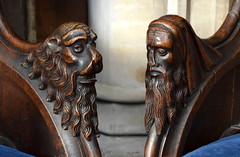 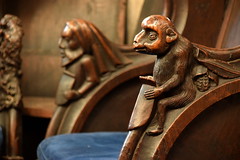
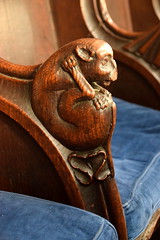 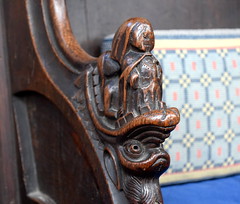 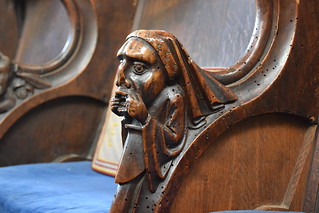
What else is there to see?
Well, the church is full of delights, and
rewards further visits which always seem
to turn up something previously
unnoticed. St George rides full tilt at a
dragon on an old chest at the west end of
the north aisle. There is good 19th
century glass in the porch and at the
west end of the nave. A clock jack
stands, axe and bell in hand, at the west
end, a twin to the one upriver at
Blythburgh. This one has a name, he's
called Southwold Jack, and he is one of
the symbols of the Adnams brewery.
As Mortlock notes, there are very few
surviving memorials. This is partly
because St Edmund was not in the
patronage of a great landed family, but
it may also suggest that they were
largely removed at the time of the 19th
century restoration, as at Brandon. One
moving one is for the child of a vicar,
and there are some interesting pre-Oxford
Movement 19th century brasses in the
south aisle.
High, high above all this, the roofs are
models of Anglo-Catholic melodrama, the
canopy of honour to the rood and the
chancel ceilure in particular. But there
is a warmth about it all that is missing
from, say, Eye, which underwent a similar
makeover. This church feels full of life,
and not a museum piece at all. I remember
attending evensong here late one winter
Saturday afternoon, and it was magical.
On another visit, I came on one of the
first days of spring that was truly warm
and bright, with not a cloud in the sky.
As we drove into town, a cold fret off of
the sea was condensing the steam of the
brewery, sending it in swirls and skeins
around the tower of St Edmund like low
cloud. It was so atmospheric that I
almost forgave them for what they have
done to the Sole Bay Inn.
|

